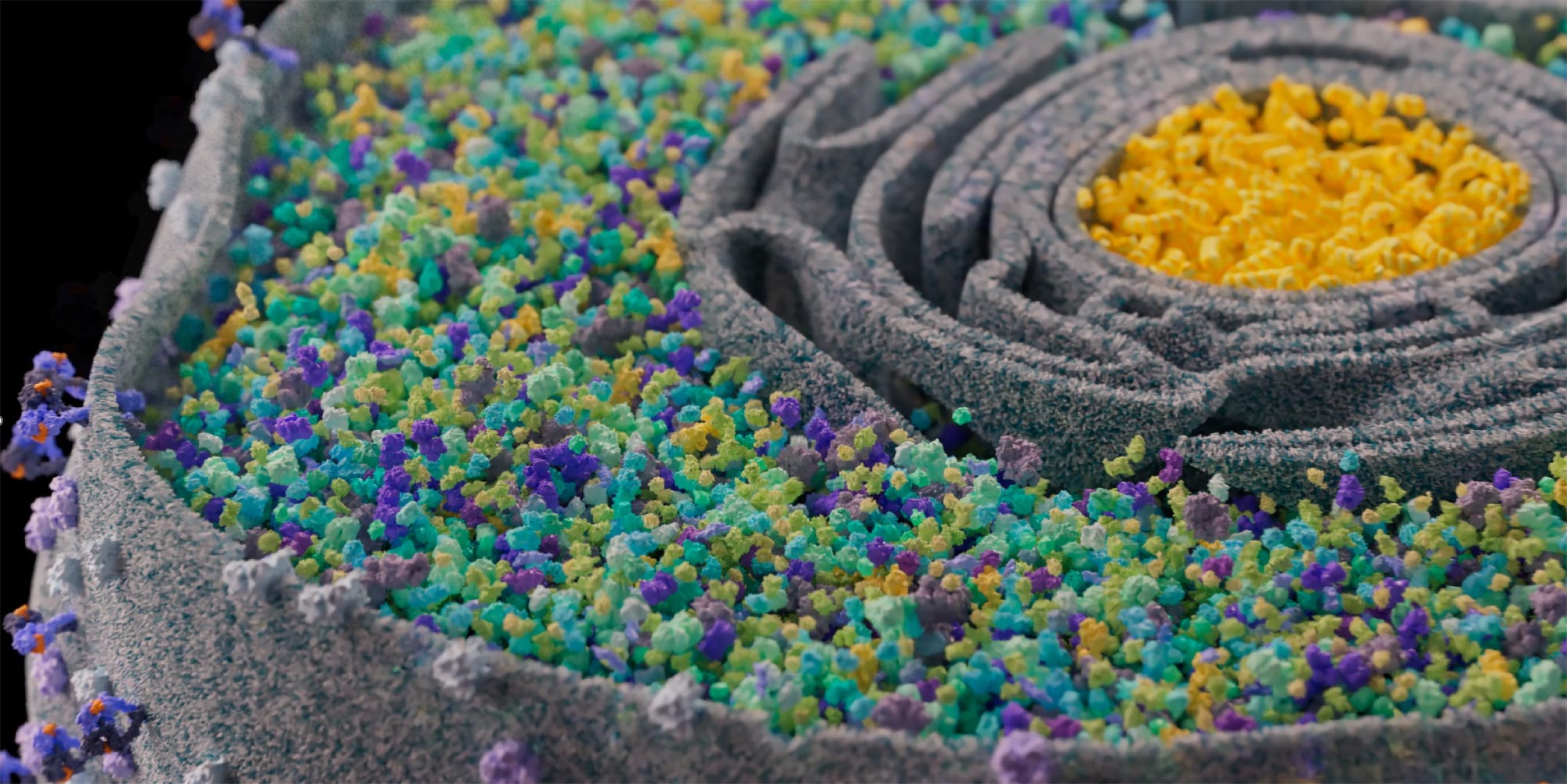Protein interactions: who is partying with whom and who is ruining the party?
Using a new method, researchers at ETH Zurich can measure alterations in the social network of proteins in cells. This work lays the foundation for the development of new drugs to treat diseases such as cancer and Alzheimer’s.

In brief
- The function of biological cells is determined by the interactions between proteins. Abnormal protein interactions are the cause of numerous diseases.
- Researchers at ETH Zurich have now developed a method for investigating protein interaction networks.
- The method and the insights gained from it are also of interest for pharmaceutical research. Active substances can be developed based on protein interactions.
Inside cells, it's like in a packed dance club: hundreds are partying. Some keep to themselves, others make their way through the crowd, chatting to everyone they meet. Some just say a quick hello, others stay with their best friends. In this club, there are all kinds of different interactions between party-goers. The same is the case in cells with proteins.
Cells are filled with many different types of proteins that interact with each other and often work together in groups. These groups are called complexes and are molecular machines that only function properly when their individual components interact.
Party-crasher interrupts normal interaction
Which proteins interact with each other and how also depends on the state of the body. Under normal conditions in a healthy body, two proteins, which we call blue and red, join together. If the conditions change due to cellular stress, for example, protein blue can change its interaction partner and join forces with protein yellow, which causes nothing but trouble and disrupts the party.

“Altered interactions between proteins can lead to diseases such as Alzheimer’s, Parkinson’s or cancer,” explains Cathy Marulli. She is a doctoral student under Paola Picotti, a professor at the Institute for Molecular Systems Biology at ETH Zurich. “It is therefore important to know how protein-protein interactions differ between healthy and diseased states and what the binding sites between two proteins look like. If we know these down to the last detail, we can develop active substances that block unwanted interactions and restore the cell’s equilibrium,” she explains.
Revealing the social network of proteins
The ETH biochemists have therefore further developed a proven approach in protein research to analyse the complete interaction network of proteins, known as the interactome.
The corresponding study has just been published in the journal external page Nature Biotechnology.
Several years ago, Picotti and her colleagues developed what is known as LiP mass spectrometry. This enables researchers to measure structural changes in thousands of proteins in any biological sample, without the samples having to be specially purified beforehand. They last used this method to analyse proteins and their functions (see ETH News).
Now they have further developed LiP mass spectrometry to study the interactions between proteins. To this end, they first identified around 6,000 interaction interfaces between proteins and other sites that change when proteins interact with each other. They then used these sites as markers to assess whether a protein changes its interaction with other proteins under a certain condition.
To do this, they used enzymes that cut proteins into pieces. These enzymes can only attack proteins at freely accessible sites. The enzyme cannot cut a protein if another protein is docked at a site. Detailed information on the protein fragments therefore helped the researchers to analyse whether and where individual proteins interact with others. This enabled them to study the interactions of about 1,000 proteins simultaneously and directly in a messy cell matrix.
Striking changes in stressed cells
The researchers worked with yeast cells to study how the interactions of proteins differ in their normal state from those in a stress situation triggered by a chemical substance.
In so doing, the biochemists discovered that the stress situation had altered around five dozen protein complexes and thus their interactions. The researchers also showed that a protein complex called SAGA plays an important role in the interaction network of the yeast cell. When they removed SAGA from the picture, around two-thirds of the protein complexes behaved differently in the stress situation. “SAGA is the DJ at the party. When it is muted, some party groups stop dancing. They influence other party-goers, who also withdraw. This shows that a single player in the cell has a disproportionately large influence on others,” says Marulli.
Transferable to other species
The method developed can also be applied to other organisms. “For each species we want to study, we just need to develop a new set of binding markers to be able to use this method to study protein interactions in mouse or human cells,” says Marulli. The next logical step is therefore to determine the interaction markers for the interactome of human cells in order to analyse defective protein interactions in a single step.
Determining protein interactions is extremely important in relation to diseases. “We therefore want to further develop our technology for diagnostic purposes and for research into disease mechanisms,” says Picotti. There is a good reason for this hope: previous approaches developed in their laboratory have already been put into practice by ETH spin-off Biognosys.
Pharmaceutical research targets interactions
Pharmaceutical research is also very interested in the interaction markers. If the interaction sites are known, researchers can efficiently search for chemical compounds that can interrupt unwanted interactions or establish new ones.
Compounds that modulate protein-protein interactions are currently a promising new direction in pharmaceutical research. Such compounds could potentially address proteins that are not accessible with current drugs. Or they can be used to develop new drugs with fewer side effects.
Reference
Dörig C, Marulli C, Peskett T, Pantolini L, Studer G, Paleari C, Frommelt F, Schwede T, de Souza N, Barral Y, Piccoti P: Global profiling of protein complex dynamics with an experimental library of protein interaction markers. Nature Biotechnology, 2024. doi: external page 10.1038/s41587-024-02432-8
Comments
No comments yet